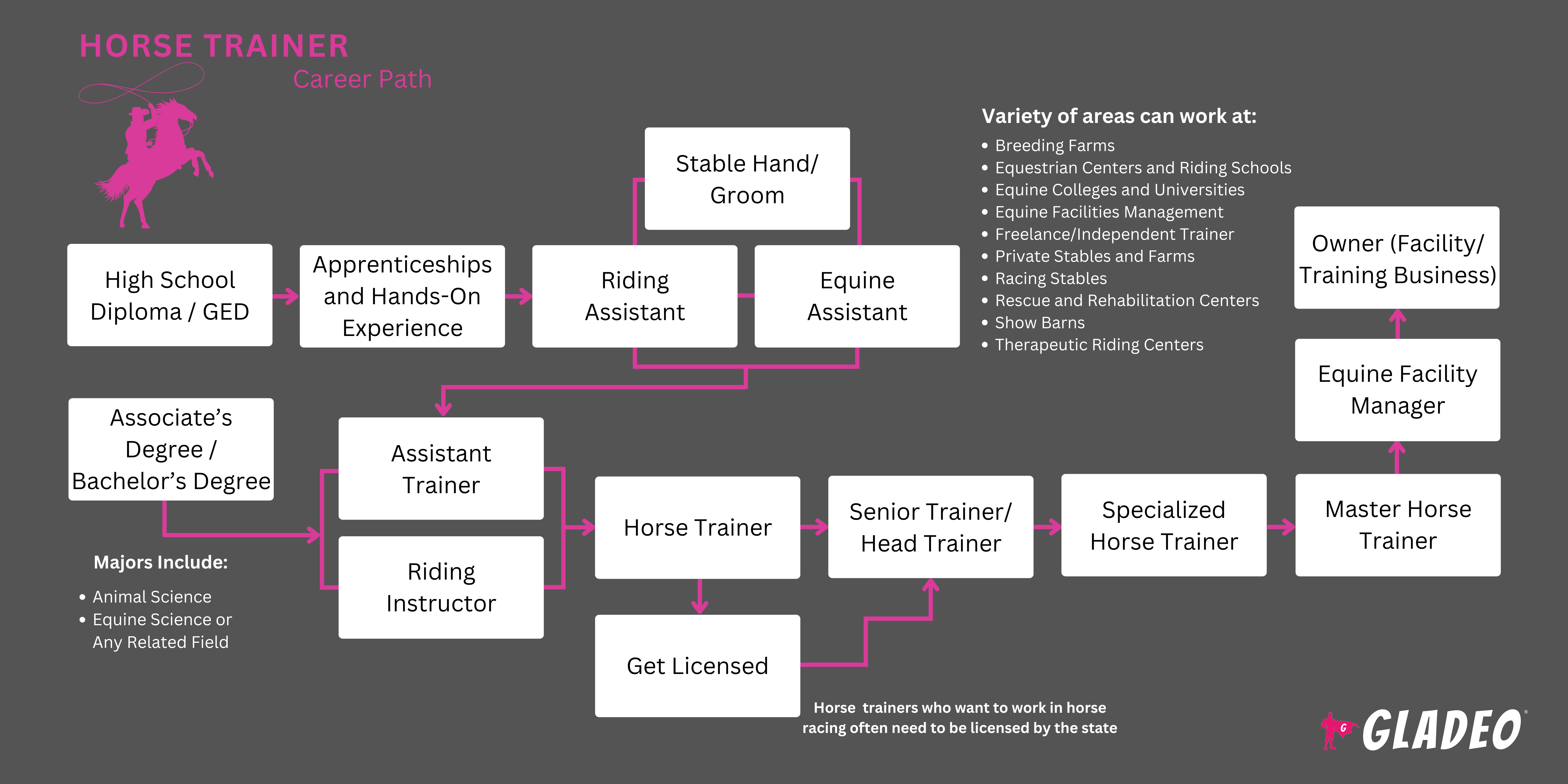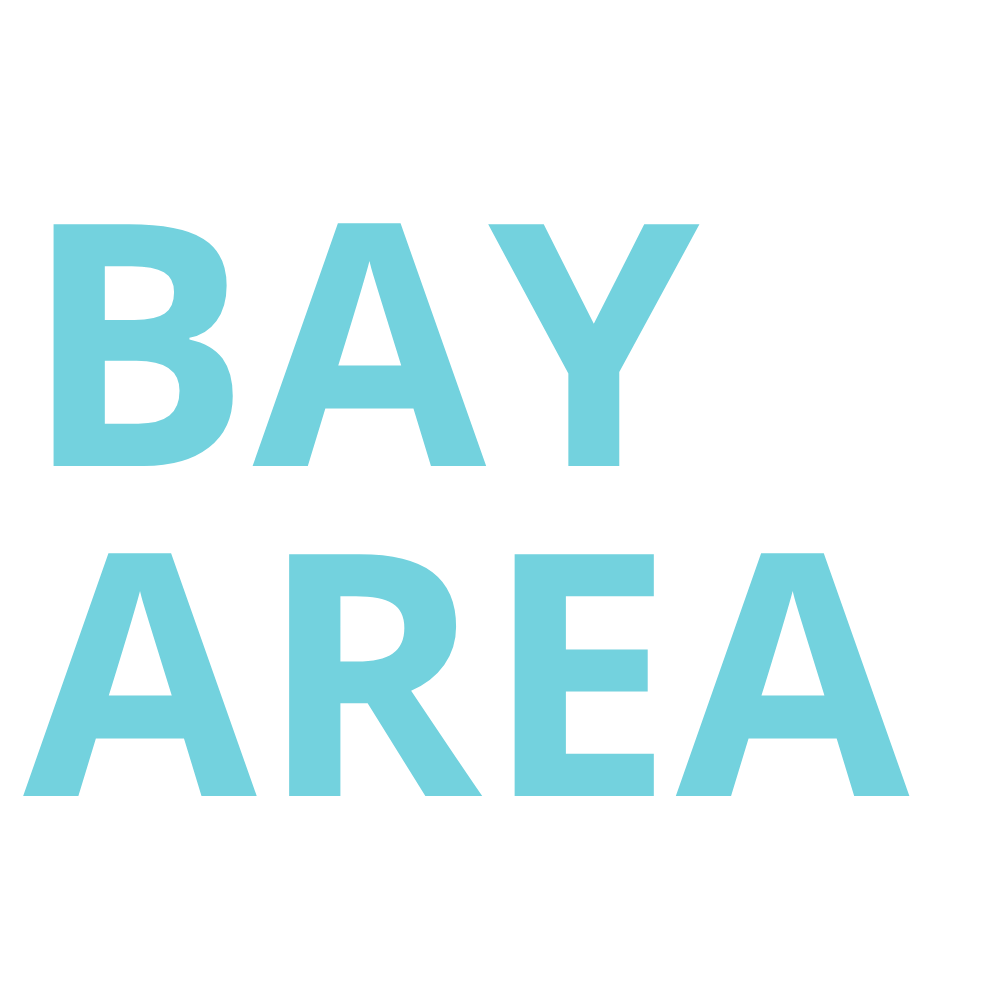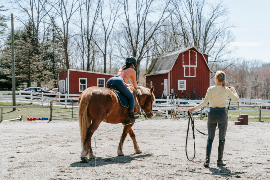Mga spotlight
Tagapagsanay ng Kabayo, Instruktor ng Pagsakay sa Kabayo, Tagapagsanay ng Kabayo, Tagapagsanay ng Dressage, Tagapagsanay ng Jumper, Tagapagsanay ng Kabayong Pangkarera, Tagapagsanay ng Kabayo, Tagapagsanay ng Pagkakabayo, Tagapagsanay ng Colt, Espesyalista sa Ugali ng Kabayo, Tagapagsanay ng Rodeo, Tagapagsanay ng Pagsakay sa Kanluran, Tagapag-alaga at Tagapagsanay ng Kabayo, Tagapamahala/Tagapagsanay ng Kwartel, Konsultant sa Ugali ng Kabayo
Ang mga kabayo ay kahanga-hanga at makikisig na nilalang na inaalagaan sa loob ng halos 6,000 taon! Napakabilis nila para sa kanilang laki, na may ilang lahi na kayang tumakbo nang hanggang 55 milya kada oras. Mabibigat sila, na may average na timbang sa pagitan ng 900 at 2,200 lbs. At malalakas sila, kaya naman ginagamit namin ang terminong "horsepower" bilang yunit ng pagsukat para sa pagganap ng makina.
Bukod sa mga katangiang ito, ang mga kabayo ay lubos ding madaling sanayin. Kaya naman umasa ang mga tao sa kanila para sa napakaraming layunin sa paglipas ng mga taon. Ngunit nangangailangan ng oras at pasensya upang lubos na sanayin ang isang kabayo, at dito pumapasok ang mga ekspertong Tagasanay ng Kabayo!
Ang mga Tagasanay ng Kabayo ay mga dedikadong propesyonal na naghihikayat sa ilang partikular na pag-uugali, nagpapalakas ng pagganap, at tinitiyak ang pangkalahatang kagalingan ng mga kabayong nasa ilalim ng kanilang pangangalaga. Maaari silang tumuon sa pagsasanay para sa mga partikular na layunin, tulad ng Western riding, karera, showjumping, o equestrian sports. Maaari rin silang magtrabaho bilang mga tagapagsanay ng rehabilitasyon na dalubhasa sa pagtulong sa mga nasugatang hayop.
Bagama't nag-iiba ang mga tungkulin depende sa kung para saan sinasanay ang kabayo, sa pangkalahatan, tinitiyak ng mga Tagasanay ng Kabayo na mauunawaan at makakatugon ang mga kabayo sa mga utos at senyas ng tao nang ligtas at epektibo. Kinikilala nila ang natatanging personalidad ng bawat kabayo at inaangkop ang mga pamamaraan ng pagsasanay upang umangkop sa mga indibidwal na pangangailangan. Bukod pa rito, nakikipagtulungan sila sa mga may-ari upang matiyak na ang mga kabayo ay tumatanggap ng wastong pangangalaga, ehersisyo, at nutrisyon.
- Paghahanda ng mga kabayo para sa ligtas at matagumpay na mga karanasan
- Pag-aambag sa kalusugan at kagalingan ng kabayo
- Pagtulong sa mga may-ari at mangangabayo na mapabuti ang kanilang koneksyon at komunikasyon sa kanilang mga kabayo
- Pagbuo ng isang mapagkakatiwalaang relasyon sa mga kabayo habang tinatamasa ang isang aktibong pamumuhay
Oras ng trabaho
- Ang mga Tagasanay ng Kabayo ay kadalasang nagtatrabaho nang mahahabang oras, karaniwan tuwing madaling araw at katapusan ng linggo. Madalas din silang naglalakbay para sa mga palabas, karera, o iba pang mga kaganapan.
Mga Karaniwang Tungkulin
- Magsagawa ng mga paunang pagtatasa sa ugali, kakayahan, at mga potensyal na pangangailangan sa pagsasanay ng kabayo.
- Magdisenyo at magpatupad ng mga programa sa pagsasanay na iniayon sa ninanais na resulta ng may-ari, sa mga partikular na disiplina sa pagsakay (kung naaangkop), at sa kakayahan ng kabayo.
- Hikayatin ang mga ninanais na pag-uugali (tulad ng pagsunod sa mga utos at pagtugon sa mga pahiwatig) sa pamamagitan ng reinforcement na nakabatay sa gantimpala tulad ng pagbibigay ng mga treat, pag-aayos, at nakakapagpakalmang pananalita.
- Magkaroon ng tiwala sa mga kabayong sinasanay. Dahan-dahang pigilan ang mga hindi kanais-nais na gawi tulad ng agresyon o paglaban.
- Magbigay ng regular na ehersisyo at pagkondisyon sa pamamagitan ng pagsakay, pag-lunge, at pagsasanay sa lupa upang mapalakas ang lakas at tibay ng kabayo.
- Pangasiwaan ang mga pangunahing gawain sa pangangalaga, tulad ng pag-aayos, pag-aayos ng mga kagamitan , at pagsuri ng mga kagamitan.
- Subaybayan ang mga isyu sa kalusugan at pag-uugali. Ibahagi ang mga alalahanin sa mga mangangabayo, may-ari, magsasaka, beterinaryo, at mga tagapag-alaga ng alagang hayop , kung kinakailangan.
- Turuan ang mga may-ari at sakay ng kabayo tungkol sa mga pinakamahuhusay na pamamaraan para sa paghawak at pag-aalaga sa kanilang mga kabayo, tulad ng pagbabahagi ng mga mungkahi sa pagkain batay sa mga aktibidad at kondisyon sa kapaligiran ng kabayo.
- Ang mga kabayo ay mga herbivore na kumakain ng damo at dayami ngunit maaaring mangailangan din ng ilang prutas at gulay, mga butil, at asin. Nangangailangan din sila ng maraming sariwang tubig!
- Maraming iba't ibang uri ng pagkain ang dapat iwasan ng mga kabayo!
- Tandaan, sa ilang mga kaso, ang mga kwalipikadong Tagasanay ng Kabayo ay nagsisilbi ring mga instruktor sa pagsakay. Maaari pa nga silang magbigay ng mga pribadong aralin sa mga lokal na estudyante at grupo!
Karagdagang Pananagutan
- Panatilihing malinis at maayos ang mga lugar ng pagsasanay at kagamitan. Umorder at tumanggap ng mga kargamento ng suplay.
- Magtakda ng iskedyul para sa pagpapakain, pagdidilig, pagpapaligo, pag-aayos, at pag-eehersisyo.
- Hugasan at linisin ang mga kagamitan, gamit, o iba pang mga bagay na nadikit sa mga kabayo.
- Magtago ng mga talaan ng mga diyeta, kalusugan, timbang, mga medikal na paggamot, at mga mahahalagang isyu.
- Mag-ayos ng medikal na paggamot at mga checkup sa mga beterinaryo.
Magbigay ng mga suplemento o mga iniresetang gamot, ayon sa mga tagubilin. - Magbigay ng serbisyo sa customer, sumagot sa mga tanong, at mag-alok ng mga rekomendasyon sa mga may-ari tulad ng kung aling mga kabayo ang bibilhin.
- Mag-ayos para sa ligtas na transportasyon at ligtas at matibay na mga kulungan ng eksibit.
- Magturo sa mga junior trainer.
Soft Skills
- Nakikibagay
- Analitikal
- Pagiging mapamilit
- Pansin sa detalye
- Pangako
- Pagkahabag
- Pagkausyoso
- Mabusisi pagdating sa detalye
- Energetic
- Independent
- Pagsubaybay
- Objectivity
- Organisado
- pasensya
- Kamalayan sa kaligtasan
- Mukhang makatarungan
Teknikal na kasanayan
- Mga kagamitan sa pagpapanatili ng arena
- Pangunahing pangangalaga sa beterinaryo at pangunang lunas
- Mga produktong panlinis at pandisimpekta
- Mga cone at pole para sa mga ehersisyo sa pagsasanay
- Koordinasyon at pisikal na tibay
- Paghawak at pagsusuri ng pag-uugali ng kabayo
- Mga first aid kit para sa mga kabayo
- Ispray para sa langaw at mga maskara para sa langaw
- Pakain at suplemento ng kabayo
- Pag-aayos at pangangalaga sa kabayo
- Masahe ng kabayo at palpitation ng kabayo
- Pag-iingat ng Talaan
- Mga kagamitan sa pagsakay, tulad ng helmet, bota, siyahan, renda, kagamitan sa pag-lunge, atbp.
- Kahusayan sa pagsakay sa iba't ibang disiplina
- Mga pamamaraan ng sanitasyon at pagdidisimpekta
- Matatag na pamamahala at mga suplay
- Mga sentro ng pagsakay sa kabayo at mga paaralan ng pagsakay
- Mga kuwadra ng karera
- Mga kuwadra ng kompetisyon
- Mga tagapagsanay na may sariling negosyo
- Mga sentro ng rehabilitasyon ng hayop, silungan, at mga ospital
- Mga sakahan at rantso
Ang mga Tagasanay ng Kabayo ay dapat mag-ingat nang sapat sa paligid ng mga kabayo – at tiyaking alam ng iba kung paano kumilos at kung ano ang mga bagay na dapat iwasan para sa kanilang kaligtasan. Sa pangkalahatan, ang mga kabayo ay palakaibigan at kadalasang nasisiyahan sa pakikisama sa mga tao. Gayunpaman, sila ay malalaki at mabibigat na hayop na madaling magulat. Kahit na hindi nila sinasadya, maaari nilang saktan ang isang tao sa pamamagitan ng hindi sinasadyang pagbangga, pagsipa, o pagkagat sa kanila.
Bukod pa rito, ang ilang mga kabayo ay maaaring hindi komportable sa mga tao at maaaring maging agresibo o matatakutin. Ang mga tagapagsanay ay kailangang maging handa na harapin ang mga naturang hayop nang may habag habang nagsisikap na makamit ang mga layunin. Kabilang sa iba pang mga potensyal na panganib ang pagkahulog mula sa isang kabayong natalisod, natisod, o tumatalon at natumba ang sakay o hinete nito. Kahit ang mga bihasang tagapagsanay ay maaaring masaktan sa isang iglap kung may magkamali, kaya kailangan nilang palaging maging alerto sa mood ng hayop, sa mga nakapalibot na pangyayari (tulad ng mga naghihiyawan na pulutong), at mga potensyal na panganib (tulad ng malalakas na ingay).
Taon ang kailangan para matutunan kung paano sanayin nang maayos ang mga kabayo. Nangangailangan din ito ng matinding pasensya, dedikasyon, at tibay. Ang trabaho ay nangangailangan ng mahahabang oras na karaniwang ginagawa tuwing umaga at katapusan ng linggo. Bukod pa rito, ang mga Tagasanay ng Kabayo ay madalas na nalalantad sa maalikabok at kung minsan ay mabahong kondisyon, pati na rin sa lahat ng uri ng panahon.
Ang modernong pagsasanay sa kabayo ay kinabibilangan ng pagbuo ng mga pakikipagtulungan sa mga kabayo, na kilala bilang natural na pagsakay sa kabayo . Sa halip na gumamit ng mga pamamaraan na nakabatay sa kontrol, sinusubukan ng mga Tagasanay ng Kabayo na gumamit ng mga pamamaraan na tumutulong sa mga kabayo na tumugon nang kusang-loob. Binibigyang-diin ng pamamaraang ito ang pag-unawa at paggalang, na ginagawang mas positibong karanasan ang pagsasanay habang nagtatatag ng tiwala sa pagitan ng kabayo at tagapagsanay.
Nagiging prayoridad din ang kalusugang pangkaisipan ng mga kabayo, kung saan gumagamit ang mga tagapagsanay ng mga ehersisyo sa pagpapahinga at mga aktibidad na hindi nakasakay upang mapanatiling kalmado, masaya, at may motibasyon ang mga kabayo! Nakakaapekto rin ang teknolohiya sa larangan, tulad ng mga wearable device upang subaybayan ang datos ng kalusugan at pagganap. Nagbibigay ito sa mga tagapagsanay ng mga kaalamang kailangan nila upang lumikha ng mga ehersisyo na iniayon sa katumpakan na nagpapanatili sa mga kabayo na malusog at handa.
Karamihan sa mga tagapagsanay ay may maagang interes sa mga kabayo at maaaring lumahok sa mga programa para sa kabataang kabayo. Malamang na aktibo sila sa mga aktibidad sa labas at nagpakita ng pasensya, kuryusidad, at kahandaang matuto tungkol sa pag-uugali ng mga hayop.
- Ang mga Tagasanay ng Kabayo ay nangangailangan ng kahit isang diploma sa hayskul kasama ang praktikal na karanasan sa mga kabayo. Marami ang nakakakuha ng karanasang iyon sa pamamagitan ng mga apprenticeship o sa pagkuha ng mga klase sa agham ng kabayo sa isang community college o unibersidad.
- Pagsakay sa kabayo
- Anatomiya at pisyolohiya ng kabayo
- Pamamahala ng pasilidad
- Pag-uugali ng kabayo
- Etika at kapakanan ng hayop
- Nutrisyon at sakit ng kabayo
- Minsan, ang mga tagapagsanay ay mga instruktor din sa pagsakay. Ang mga sertipikasyon na may kaugnayan sa pagtuturo ay maaaring maging kapaki-pakinabang, kabilang ang:
- Sertipikadong Asosasyon ng Pagsasanay sa Kabayo - Sertipikasyon ng Instruktor o Tagapamahala ng Pasilidad ng Kabayo
- Asosasyon ng mga Instruktor sa Pagsakay sa Amerika - Sertipikasyon ng Instruktor
- Programa ng Sertipikasyon ng Tagapagsanay - Asosasyon ng Hunter Jumper ng Estados Unidos
- Ang mga tagapagsanay ay dapat na patuloy na matuto upang mapabuti at mapalawak ang kanilang mga kasanayan.
- Ang ilang mga estado ay nangangailangan ng lisensya para sa mga tagapagsanay ng kabayong pangkarera at mga instruktor sa pagsakay.
- Bilang karagdagan, ang mga nagpapatakbo ng kanilang sariling negosyo ay kailangang:
- Kumuha ng lisensya sa negosyo at umupa o bumili ng angkop na kuwadra at lugar para sa pagsakay na walang mga pang-abala at ingay sa labas.
- Mag-brand at mag-advertise ng kanilang negosyo.
- Magtatag ng online presence sa pamamagitan ng website, Google Business profile, social media, at iba pang angkop na platform.
- Makipagtulungan sa mga may-ari ng kabayo, mga mangangabayo, mga hinete, at mga asosasyon ng kabayo upang bumuo ng isang base ng mga kliyente.
- Bumuo ng isang mahusay na paraan para makapag-book ng mga appointment at makapagbayad ang mga kliyente.
- Bumuo at magpanatili ng magandang relasyon sa kliyente para sa paulit-ulit na pakikipag-ugnayan. Magpatupad ng mga paraan ng pagpapanatili ng kliyente, tulad ng mga follow-up na email o mga programa ng katapatan.
- Umorder ng mga suplay, tulad ng:
• Mga siyahan at pad ng siyahan
• Mga bridle at bits
• Mga kagamitan sa pag-lunge (hal., mga lunge lines, mga latigo)
• Mga pantulong sa pagsasanay (hal., martingale, side reins)
• Mga helmet at kagamitang pangproteksyon para sa mga nakasakay
• Mga kagamitan sa pag-aayos (hal., mga brush, mga piko sa kuko, mga suklay para sa kiling ng buhok)
• Ispray para sa langaw at mga maskara para sa langaw
• Mga first-aid kit para sa mga kabayo
• Pakain at mga suplemento ng kabayo
• Mga balde ng tubig at mga lalagyan ng pagkain ng hayop
• Mga kumot at sapin sa kama para sa iba't ibang kondisyon ng panahon
• Mga kagamitan sa pagpapanatili ng arena (hal., mga drag rakes, kagamitan sa pagdidilig)
• Mga kono at poste para sa mga ehersisyo sa pagsasanay
• Mga suplay para sa kuwadra (hal., mga balde ng dumi, tinidor, pala)
• Mga produktong panlinis at pangdisimpekta
• Mga bota at balot ng kabayo
• Mga halter ng kabayo at mga lubid na tingga
• Mga kagamitan sa pagtatala (hal., mga talaan ng pagsasanay, mga talaan ng kalusugan)
- Kumuha ng insurance para sa pananagutan, propesyonal na bayad-pinsala, at saklaw ng ari-arian.
- Subaybayan ang kita at mga gastusin. Magsumite ng mga buwis ng estado at pederal.
- Hindi kailangan ng mga tagapagsanay ng kabayo ang isang degree sa kolehiyo, ngunit ang pagkuha ng mga klase at pagkamit ng mga sertipikasyon ay makakatulong sa pagbuo ng kaalaman at karanasan!
- Maghanap ng mga programa sa agham ng kabayo na nag-aalok ng mga kurso sa pangangabayo, anatomiya ng kabayo, pisyolohiya ng kabayo, pag-uugali ng kabayo, mga pamamaraan sa pagsasanay, pamamahala ng kuwadra, kapakanan ng hayop, at pagkontrol ng sakit.
- Tandaan, ang mga online na kurso ay maaaring angkop para sa ilang mga paksa, ngunit subukang makakuha ng mas maraming praktikal na karanasan hangga't maaari.
- Maghanap ng mga pagkakataon upang magpakadalubhasa sa isang disiplina na interesado ka, tulad ng dressage o showjumping.
- Paghambingin ang mga gastos sa matrikula at mga bayarin, na binabanggit ang mga gastos sa loob ng estado kumpara sa labas ng estado.
- Suriin ang mga opsyon sa scholarship at tulong pinansyal.
- Huwag ding kalimutang tingnan ang mga oportunidad sa apprenticeship!
Maaaring direktang ialok ang mga ito mula sa mga lokal na negosyo, kaya maaaring kailanganin mong magsaliksik o makipag-ugnayan sa kanila upang magtanong kung ano ang kanilang iniaalok.
- Ang landas tungo sa pagiging isang Tagasanay ng Kabayo ay hindi laging diretso.
- Ang ilang mga estudyante ay nakikipagtulungan sa mga kabayo mula pa sa murang edad at maaaring matuto kung paano magsanay sa pamamagitan ng isang apprenticeship.
- Ang iba ay maaaring dumalo sa mga programa sa kolehiyo sa pag-aaral ng kabayo o matuto sa mga nakalaang paaralan ng kalakalan tulad ng Lyons Legacy Equestrian Academy , Equine Studies Institute , o United States Hunter Jumper Association .
- Sa hayskul, pag-aralan ang mga paksang may kaugnayan sa hayop, pati na rin ang Ingles, matematika, biyolohiya, at negosyo.
- Sumali sa mga equestrian club, 4-H , National High School Rodeo Association , o iba pang mga grupong nakatuon sa mga hayop.
- Dumalo sa mga workshop o kampo na nakatuon sa pangangabayo at pangangalaga sa kabayo.
- Magpasya nang eksakto kung anong larangan ang gusto mong espesyalisasyon. Magbasa ng mga artikulo at manood ng mga how-to video na may kaugnayan sa Pagsasanay sa Kabayo. Tingnan ang aming listahan ng mga Inirerekomendang Mapagkukunan para sa mga mungkahi!
- Magkaroon ng karanasan sa paggamit ng mga kabayo sa pamamagitan ng pagboboluntaryo sa mga kuwadra.
- Suriin nang maaga ang mga patalastas ng trabaho upang malaman ang tungkol sa mga karaniwang kinakailangan para sa mga aplikante.
- Mag-apply para sa mga part-time na trabaho, internship, o apprenticeship kung saan makakakuha ka ng totoong karanasan sa pagtatrabaho nang direkta sa mga hayop.
- Makipag-ugnayan sa mga nagtatrabahong Tagasanay ng Kabayo upang humiling ng isang panayam na nagbibigay ng impormasyon . Tingnan kung maaari mo silang samahan sa trabaho nang isang araw!
- Subukang bumuo ng network nang maaga. Ang lokal na komunidad ng mga mangangabayo ay maaaring medyo maliit at malapit sa isa't isa, kaya lumikha ng reputasyon bilang isang ligtas, maalam na estudyante, handang matuto at handang gawin ang mga kinakailangang gawain.
- Gumawa ng portfolio ng iyong mga tagumpay sa pagsasanay, kabilang ang mga halimbawa ng iyong trabaho bago at pagkatapos.
- Makisali sa mga online forum at magtanong sa mga batikang propesyonal!

- Kumpletuhin ang kinakailangang pagsasanay para sa trabahong nais mong aplayan.
- Makipag-ugnayan sa iyong network sa komunidad ng mga mangangabayo. Humingi ng mga tip tungkol sa mga bakanteng trabaho. Maraming trabahong may kaugnayan sa kabayo ang matatagpuan sa pamamagitan ng mga personal na koneksyon!
- Dumalo sa mga kaganapan sa pagsakay sa kabayo at sumali sa mga asosasyon tulad ng Certified Horsemanship Association upang manatiling may alam sa mga oportunidad sa trabaho.
- Tanungin ang mga dating katrabaho, superbisor, guro, o kliyente kung maaari silang magsilbing personal na sanggunian. Huwag ibigay ang kanilang impormasyon sa pakikipag-ugnayan nang walang pahintulot.
- I-scan ang mga job portal tulad ng Indeed.com , Glassdoor , ZipRecruiter , at Craigslist .
- Mag-apply para sa mga full o part-time na trabaho, internship, o apprenticeship.
- Suriin ang mga post ng trabaho para sa mga keyword at parirala, at isama ang mga iyon sa iyong mga materyales sa aplikasyon (kung naaangkop). Maaaring kabilang sa mga sikat na keyword ang:
- Ugali ng Kabayo
- Paghawak ng Kabayo
- Mga Teknik sa Pagsasanay
- Tagubilin sa Pagsakay
- Nutrisyon ng Hayop
- Kalusugan at Kagalingan
- Pamamahala ng Matatag
- Pagbabago sa Pag-uugali
- Mga Kasanayan sa Pagsakay sa Kabayo
- Mga Protokol ng Pangkaligtasan
- Suriin ang mga halimbawang resume ng Horse Trainer at magsaliksik ng mga potensyal na tanong sa interbyu.
- Magsama ng link sa iyong online portfolio na nagpapakita ng iyong trabaho gamit ang mga kabayo, kasama ang mga larawan o video (kung pinahihintulutan) na nagpapakita ng iyong mga kasanayan sa paghawak at pagsasanay.
- Manatiling updated sa mga trend at pamamaraan sa industriya ng kabayo upang maipakita ang kaalaman at kakayahang umangkop sa mga panayam.
- Maging pamilyar sa bokabularyo ng larangan ng pagsasanay sa kabayo.
- Sa mga panayam: Manamit nang propesyonal, ipahayag ang tunay na sigasig sa pakikipagtulungan sa mga kabayo, at bigyang-diin ang iyong pangako sa matataas na pamantayan at mga ligtas na gawain.
- Iwasang magmukhang "alam na ang lahat." Pinahahalagahan ng maraming employer ang mga kandidatong bukas ang isipan, madaling umangkop, at handang matuto sa pamamagitan ng patuloy na pagsasanay at gabay.
- Magtakda ng mga panandalian at pangmatagalang layunin sa karera. Regular na suriin ang mga layuning iyon upang matiyak na nasa tamang landas ka. Maging handang umangkop habang lumilitaw ang mga bagong oportunidad o espesyalisasyon sa larangan.
- Bumuo ng positibong reputasyon sa pamamagitan ng patuloy na ligtas at epektibong pagsasanay sa mga kabayo.
- Dumalo sa mga workshop para sa patuloy na edukasyon at kumuha ng mga espesyal na sertipikasyon upang maipakita ang kadalubhasaan.
- Magpakadalubhasa sa isang partikular na disiplina o kasanayan sa pagsakay upang makaakit ng mga kliyente sa larangang iyon.
- Panatilihin ang pakikipag-ugnayan sa loob ng komunidad ng mga mangangabayo, kabilang ang mga coach, beterinaryo, at mga mangangabayo.
- Manatiling organisado at nasa iskedyul. Maghanap ng mga paraan upang mapabuti ang kahusayan at produktibidad, habang nananatiling sumusunod sa mga patakaran ng employer, mga tuntunin ng organisasyon, at mga regulasyon ng estado o pederal.
- Makilahok sa mga propesyonal na organisasyon tulad ng United States Equestrian Federation upang matuto, makipagkaibigan, at tumuklas ng mga oportunidad (tingnan ang aming listahan ng mga Inirerekomendang Mapagkukunan ).
- Pag-iba-ibahin ang iyong mga kasanayan sa pamamagitan ng pag-aaral tungkol sa rehabilitasyon ng kabayo o mga therapy na tinutulungan ng kabayo.
- Humingi ng mentorship mula sa mga bihasang tagapagsanay na dalubhasa sa iyong mga larangang interes.
- Kung wala nang pagkakataong lumago kasama ang iyong kasalukuyang employer, isaalang-alang ang pag-apply sa isang mas malaking organisasyon — o pagsisimula ng sarili mong negosyo. Gumawa ng matibay na plano sa negosyo at kumonsulta sa mga batikang tagapayo para sa mga tip.
- Mamuhunan sa mga kasanayan sa digital marketing upang mapalago ang iyong reputasyon kung isinasaalang-alang mo ang self-employment o naghahanap ng mga kilalang kliyente.
Mga website
- American Farriers Journal
- American Humane Association
- American Paint Horse Association
- American Quarter Horse Association
- Asosasyon ng mga Instruktor sa Pagsakay sa Amerika
- American Society for the Prevention of Cruelty to Animals
- American Society of Animal Science
- American Veterinary Society of Animal Behavior
- Center for Disease Control
- Mga Certified Applied Animal Behaviorist
- Sertipikadong Asosasyon ng Pagsasanay sa Kabayo
- Balita sa Kalakalan ng mga Kabayo
- Samahan ng Agham ng Kabayo
- Journal ng Beterinaryo ng Kabayo
- Kabayo at Sakay
- Kabayo na Inilalarawan
- International Horsemanship Association
- Pambansang Asosasyon ng Kabayo ng Barrel
- National Reining Horse Association
- Mga Tao para sa Etikal na Pagtrato sa mga Hayop
- Propesyonal na Asosasyon ng Therapeutic Horsemanship International
- Asosasyon ng mga Propesyonal na Rodeo Cowboys
- Balita sa Quarter Horse
- SPANA
- Pamamahala ng Matatag
- Ang Kronika ng Kabayo
- Ang Kabayo: Ang Iyong Gabay sa Pangangalaga sa Kalusugan ng Kabayo
- Pederasyon ng Dressage ng Estados Unidos
- Pederasyon ng Kabayo ng Estados Unidos
- Asosasyon ng mga Kaganapan sa Estados Unidos
- Samahan ng mga Mangangaso na Tumatalon sa Estados Unidos
- United States Pony Club
- Asosasyon ng mga Tagasanay ng Kabayo sa Paglalakad
- Mga Warmblood Ngayon
Mga libro
- 101 Ehersisyo sa Pagsasanay sa Lupa para sa Bawat Kabayo at Tagapangalaga , ni Cherry Hill
- Pagsasanay sa Pundamental na Gawain para sa Iyong Kabayo: Bumuo ng Mas Malalim na Ugnayan sa Iyong Kabayo sa Pamamagitan ng Iba't Ibang Ehersisyo at Laro, ni Lesley Bayley
- Utak ng Kabayo, Utak ng Tao: Ang Neuroscience ng Pagkakabayo , ni Janet Jones PhD
- Ang Pagbibilang ng Modernong Mangangabayo Patungo sa Bagong Sira na Edisyon: Tunay na Pagsasanay sa Kabayo na Gawin Mo Mismo sa 33 Komprehensibong Aralin , nina Sean Patrick at Charles Hilton
- Ang Orihinal na Bibliya ng Kabayo: Ang Tiyak na Pinagmulan para sa Lahat ng Bagay na Tungkol sa Kabayo , nina Moira C. Reeve at Sharon Biggs
Ang mga tagapagsanay ng kabayo ang susi sa masaya at ligtas na karanasan sa pagsakay sa iba't ibang lugar. Ang mga ito ay mga gawaing praktikal at, bagama't kapaki-pakinabang, mayroon din itong kaakibat na mga hamon at panganib. Kung interesado kang tuklasin ang ilang kaugnay na trabaho, tingnan ang mga mungkahi sa ibaba!
- Hayop Behaviorist
- Tagapag-aanak ng Hayop
- Tagapag-alaga ng Hayop
- Animal Control Worker
- Animal Nutritionist
- Photographer ng Hayop
- Tagasanay ng Hayop
- Tagasanay sa Kabayo
- Magsasaka o Rancher
- Marine Biologist
- Tagapamahala ng Kuwadra
- Beterinaryo
- Veterinary Assistant
- Zoologist at Wildlife Biologist
Newsfeed

Mga Tampok na Trabaho

Mga Online na Kurso at Tool







